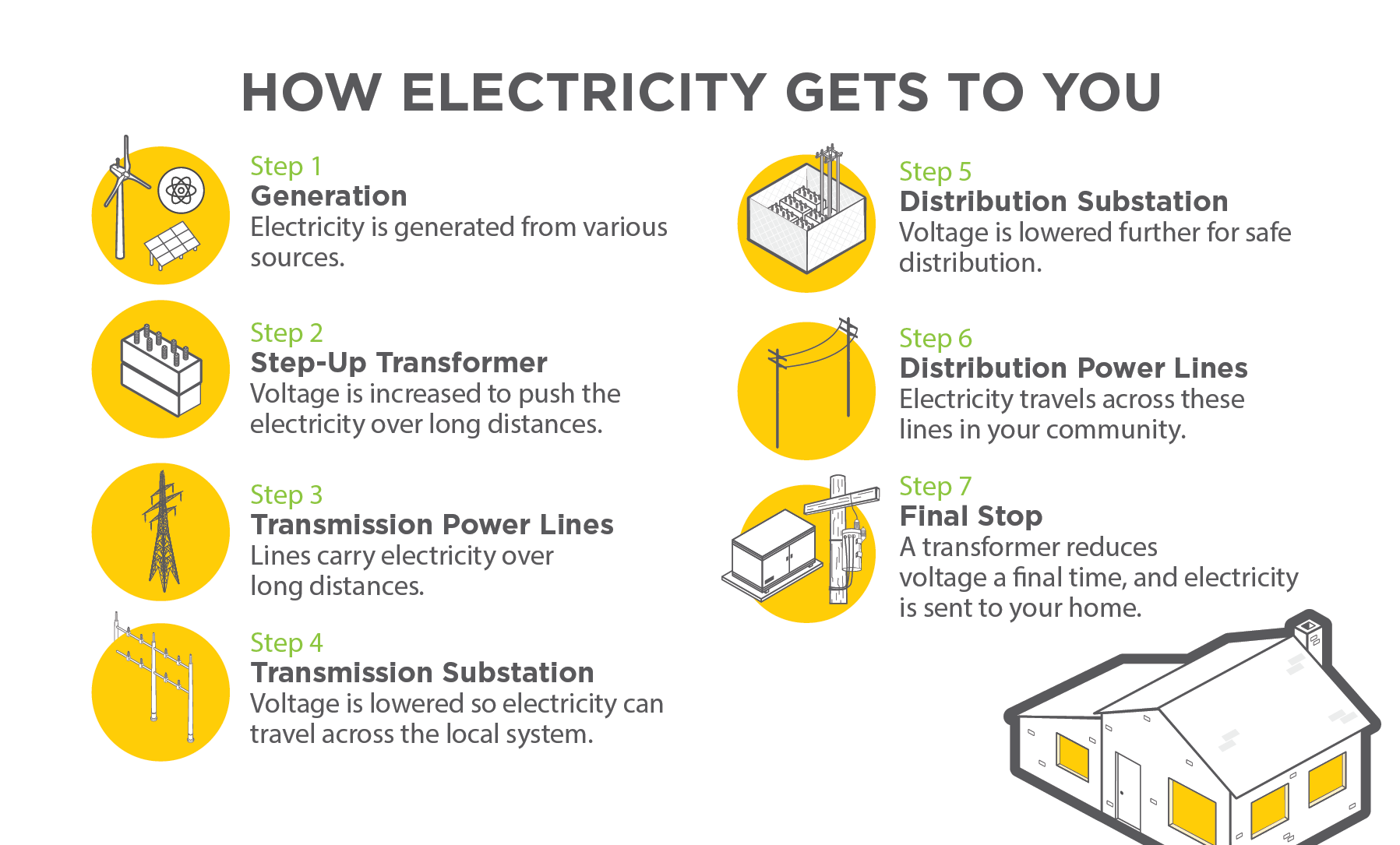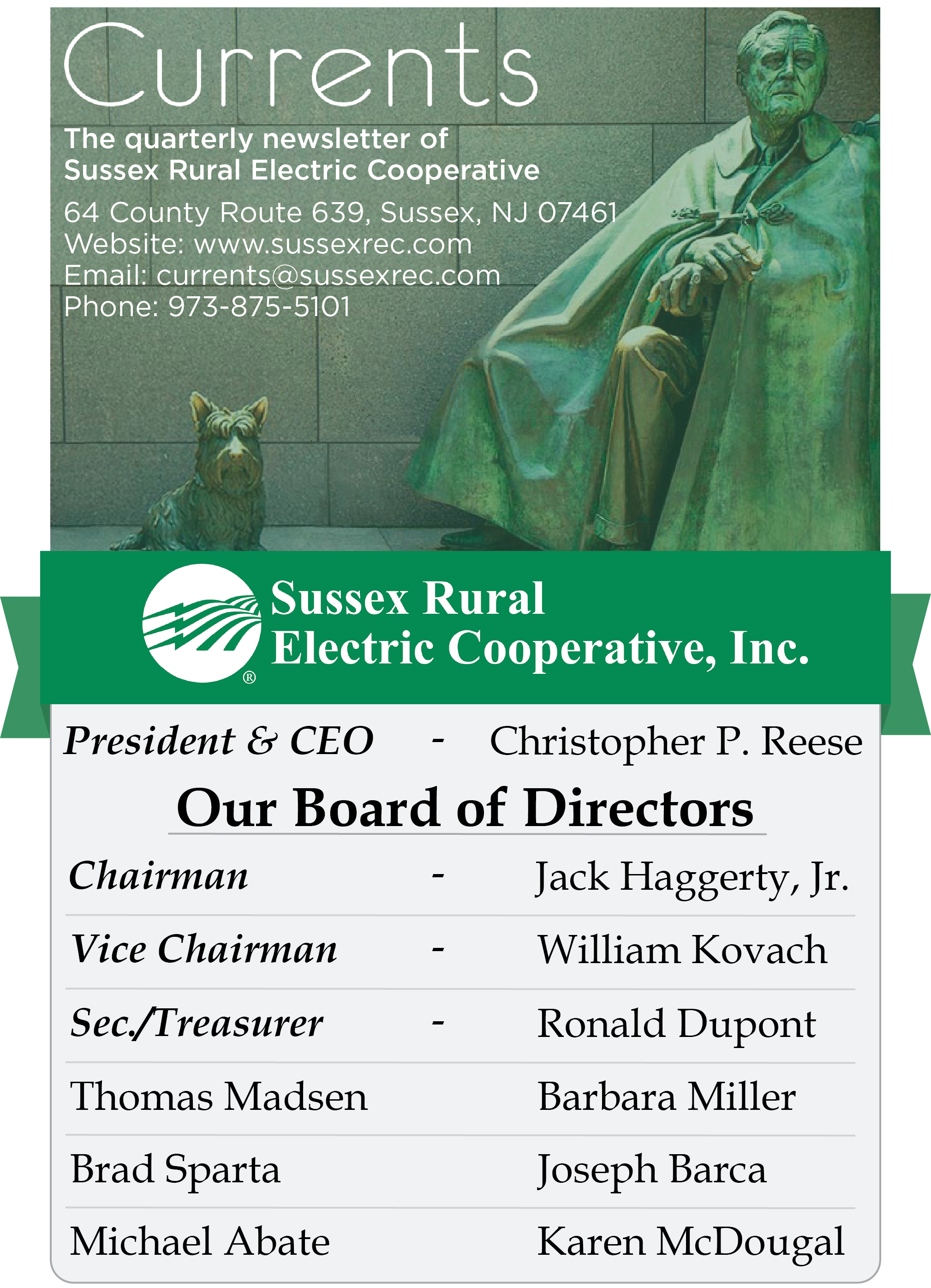To view the full print/pdf version of Volume 2, Issue 1 of Currents, click here
For previous issues of Currents, visit our Currents Library
Electric Grid 101
By: Steve Sokolowski, Marketing Associate
Email: ssokolowski@sussexrec.com
Electricity plays a vital part in our daily lives. It can be hard to imagine what life was like for those who lived in our area before Sussex Rural Electric Cooperative was formed in 1937 to bring power to our community. Today, we depend on it for essentials like light, heating, cooling, and refrigeration, for entertainment like gaming or streaming movies or TV shows, and for powering the modern necessities that keep us connected to the rest of the world.
Our access to electricity at the flip of a switch is thanks to the hard work and vision of thousands of people who worked to build the modern electric grid and those who now work behind the scenes to keep it running.
Beginner’s Guide to the Electric Grid
The local system that delivers power throughout Sussex REC’s service territory is just a small part of a much larger, even more complex system that interconnects homes and businesses throughout the United States. The US electric grid is composed of three main grids: the Eastern Interconnection (which Sussex REC’s system is a part of), the Western Interconnection, and the Electric Reliability Council of Texas. These grids operate independently but are interlinked so power can flow through each as needed. Hundreds of independent utilities, many of them co-ops like Sussex REC, own and maintain their own systems within each of these grids.
A major complexity that affects the grid is supply and demand for power. Demand for electricity can vary greatly depending on time of day, outside temperature, and weather. Electric providers must plan for these swings and either produce or purchase enough electricity so it’s available exactly when it’s needed. Regional transmission organizations help make sure the system stays balanced and can adjust in real time to meet these challenges.
Where Your Power Comes From
The electric grid exists to bring power from its source to the homes and businesses of those who will use it. Power plants come in many different shapes and sizes, though they are always the source that the electric grid takes power from to deliver to consumers. Utilities either have deals with or ownership of power plants and secure energy to provide to the people on their lines. That power can come from nuclear energy, fossil fuels like natural gas or coal, or renewable sources like hydropower, solar, or wind.
From the power plant, electricity is stepped up by a “step-up transformer,” which increases voltage to help it travel over long distances. It moves through high-voltage transmission lines which are held up by the massive towers you’d see along a major highway. This is the “generation and transmission” phase, which occurs before electricity reaches the distribution system where it will be used (for example, Sussex REC’s local system). Along the way, it will typically be stepped down by a transmission substation before it nears its destination.
Power is stepped down again at a distribution substation to lower voltage to safe levels for lower-voltage lines. These distribution power lines are the ones you’d see along local roads, typically strung on wooden poles. Electric distribution lines exist at the top of the pole, sometimes placed over lines for cable, telephone, and internet services. Distribution lines carry electricity to homes, schools, and businesses and step down power one final time through a transformer (either pole-mounted or ground-mounted). This makes sure the electricity is safe to use for each and every one of your everyday tasks.

Ensuring Reliable Power
An important facet of the planning that goes into the electric grid is ensuring reliability for consumers. One way that utilities do this is to make sure that they are receiving power from multiple sources. This way, if one is for some reason unavailable, they still have access to electricity through another source.
Sussex REC’s power comes from a variety of sources, managed through our generation & transmission partner Allegheny Electric Cooperative. Our current power mix is made up of approximately 54% nuclear power from the Susquehanna Steam Electric Station. 9% is hydropower from the Raystown Hydroelectric Plant and the Niagara Power Project. We purchase the rest of our power on the open market from various power sources. Overall, our power mix is approximately 80% carbon free.
Technology also plays a big part in reliability. For example, we use Automatic Metering Infrastructure to receive data over our power lines from our members’ meters. This data helps us see usage trends and detect potential service problems. Our outage monitoring system also allows us the ability to remotely monitor outage situations and, using new software, it can also automatically perform switching as needed to redirect power to areas affected by an outage while our crews work on making repairs.
And of course, trees are a major part of the equation for any utility that serves an area like ours. Our vegetation management program targets trees that could pose potential threats to the flow of power in our system. You can read more about these efforts in this issue’s main article. The costs associated with securing the right type of equipment, software, and manpower needed to manage our electric grid are funded through the System Connection Fee which you’ll see on your monthly bill. All of this is critical in making sure power can flow where it’s needed reliably and safely.
For more information on how Sussex REC brings your power to you, check out our animated Watts It About video!




